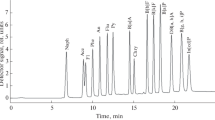Abstract
A sample preparation technique was developed to isolate and separate two classes of combustion-produced pollutants: three- to six-ring polycyclic aromatic hydrocarbons (PAH) and polychlorinated dibenzo-p-dioxins and dibenzofurans (PCDD/F), from sediment samples for interference-free analyses by gas chromatography/mass spectrometry (GC/MS). The method involves soxhlet extraction with methylene chloride, sulfur removal with activated copper powder, gel filtration chromatography with Sephadex LH-20, polarity separations of PAH and PCDD/F with prepacked silica gel solid-phase extraction columns, and isolation of PCDD/F from polychlorinated biphenyls with microalumina columns. Stringent procedural controls were established to achieve clean isolations and recoveries of 70% or better for each step in the method. The prepared sample extracts were analyzed by capillary GC and GC/MS. Electron impact ionization was used for PAH, and negative chemical ionization with methane as a reagent gas was used for PCDD/F. Reproducible results were obtained. The method is simple and has the advantage of conserving sample consumption since two classes of compounds can be analyzed from the same sample. This can be critical in sediment core analyses where sample size is usually limited.
Similar content being viewed by others
Literature Cited
Baker-10 SPE Application Guide. 1982. Volume I. Baker Publishing, Phillipsburg, New Jersey.
Baker-10 SPE Application Guide. 1984. Volume II. Baker Publishing, Phillipsburg, New Jersey.
Czuczwa, J. M. andR. A. Hites. 1986. Airborne dioxins and dibenzofurans: Sources and fates.Environmental Science and Technology 20:195–200.
Heit, M. 1985. The relationship of a coal fired power plant to the levels of polycyclic aromatic hydrocarbons in the sediment of Cayuga Lake.Water, Air, and Soil Pollution 24:41–61.
Heit, M., Y. L. Tan, C. Klusek, andJ. C. Burke. 1981a. Anthropogenic trace elements and polycyclic aromatic hydrocarbon levels in sediment cores from two lakes in the Adirondack acid lake region.Water, Air, and Soil Pollution 15: 441–464.
Heit, H., Y. L. Tan, andK. M. Miller. 1988. The origin and deposition history of polycyclic aromatic hydrocarbons in the Finger Lakes region of New York.Water, Air, and Soil Pollution 37:85–110.
Heit, M., Y. Tan, and L. Toonkel. 1981b. An Evaluation of Methodologies for Measuring Polycyclic Aromatic Hydrocarbons (PAH) in Sediment.Environmental Report, USDOE Report EML-390, New York, NY, p. I-213.
Junk, G. A., M. J. Avery, andJ. J. Richard. 1988. Interferences in solid-phase extraction using C-18 bonded porous silica cartridges.Analytical Chemistry 60:1347–1350.
Laflamme, R. E. andR. A. Hites. 1977. The global distribution of polycyclic aromatic hydrocarbons in resent sediments.Geochimica Cosmochimica Acta 42:289–303.
Lamparski, L. L., T. J. Nestrick, andR. H. Stehl. 1979. Determination of part-per-trillion concentrations of 2,3,7,8-tetrachlorodibenzo-p-dioxin in fish.Analytical Chemistry 51: 1453–1458.
Later, D. W., B. W. Wilson, andM. L. Lee. 1985. Standardization of alumina and silica adsorbents used for chemical class separations of polycyclic aromatic compounds.Analytical Chemistry 57:2979–2984.
Majors, R. E. 1991. An overview of sample preparation.LC-GC 9:16–20.
Marble, L. K. and J. J. Delfino. 1988. Extraction and solid phase cleanup methods for pesticides in sediment and fish.American Laboratory p. 23–32.
Nestrick, T. J. andL. L. Lamparski. 1982. Isomer-specific determination of chlorinated dioxins for assessment of formation and potential environmental emission from wood combustion.Analytical Chemistry 54:2292–2299.
Niles, R. andY. L. Tan. 1989. Determination of polynuclear aromatic hydrocarbons and mononitrated derivatives in air and diesel particulates.Analytica Chimica Acta 221:53–63.
Rappe, C., P.-A. Bergquist, andL.-O. Kjeller. 1989. Levels, trends and patterns of PCDDs and PCDFs in Scandinavian environmental samples.Chemosphere 18:651–658.
Ryan, J. J., H. B. S. Conacher, L. G. Panopio, B. P.-Y. Lau, andJ. A. Hardy. 1991. Gas chromatographic separations of all 136 tetra- to octa-polychlorinated dibenzo-p-dioxins and polychlorinated dibenzofurans on nine different stationary phases.Journal of Chromatography 541:131–183.
Smith, L. M., D. L. Stalling, andJ. L. Johnson. 1984. Determination of parts-per-trillion levels of polychlorinated dibenzofurans and dioxins in environmental samples.Analytical Chemistry 56:1830–1842.
Tan, Y. L. 1979. Rapid sample preparation technique for analyzing polynuclear aromatic hydrocarbons in sediment by gas chromatography-mass spectrometry.Journal of Chromatography 176:319–327.
Tan, Y. L. 1988. Analysis of polynuclear aromatic hydrocarbons in shale oil and diesel particulates.Analytical Letters 21: 553–562.
Tan, Y. L. andM. Heit. 1981. Biogenic and abiogenic polynuclear aromatic hydrocarbons in sediments from two remote Adirondack lakes.Geochimica Cosmochimica Acta 45:2267–2279.
United States Environmental Protection Agency. 1990. EPA Method 1613: Tetra-through octa chlorinated dioxins and furans by isotope dilution HRGC/HRMS. United States Environmental Protection Agency, Office of Water Regulations and Standards, Washington, D.C.
Wakeham, S. G., C. Schaffner, andW. Geiger. 1980. Polynuclear aromatic hydrocarbons in recent lake sediments—I. Compounds having anthropogenic origins.Geochimica Cosmochimica Acta 44:403–413.
Author information
Authors and Affiliations
Rights and permissions
About this article
Cite this article
Tan, Y.L., Kong, A. & Chiu, Yo. Sample preparation for analyzing polycyclic aromatic hydrocarbons and polychlorinated dibenzo-p-dioxins and dibenzofurans in sediment by gas chromatography/mass spectrometry. Estuaries 16, 427–432 (1993). https://doi.org/10.2307/1352590
Received:
Accepted:
Issue Date:
DOI: https://doi.org/10.2307/1352590




